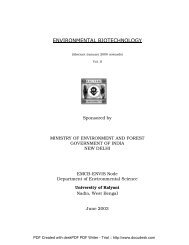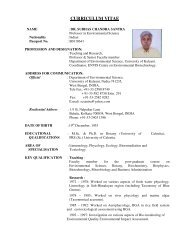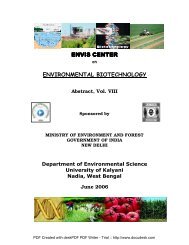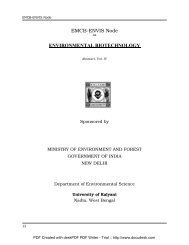EMCB-ENVIS Node ENVIRONMENTAL BIOTECHNOLOGY
EMCB-ENVIS Node ENVIRONMENTAL BIOTECHNOLOGY
EMCB-ENVIS Node ENVIRONMENTAL BIOTECHNOLOGY
You also want an ePaper? Increase the reach of your titles
YUMPU automatically turns print PDFs into web optimized ePapers that Google loves.
<strong>EMCB</strong>-<strong>ENVIS</strong> Centre<br />
The Cd concentration in leaves was 0.1 in control and 38.4, 93.1, and 177.2 μg.g -1 (dry mass) in<br />
Cd-treated food. The concentration in snail tissues increased with increasing Cd concentrations<br />
in the food. The bioaccumulation factors ranged from 4.8 (control) to 2.4 (highest exposed<br />
group), indicating a biomagnification of Cd in this food chain. The growth of the snails treated<br />
with Cd was reduced by 17, 24, and 43% respectively, compared to the control group.<br />
Comparison of these results with those obtained with snails exposed to similar Cd concentrations<br />
in a vegetable flour revealed that accumulation and effects were relatively consistent,<br />
demonstrating a comparable bioavailability of Cd in the two diets. Tests using growing H.<br />
aspersa snails exposed to metals in flour or fresh leaves can be useful for risk assessment<br />
purposes.<br />
Ron van der Oost, Jonny Beyer, Nico P. E. Vermeulen. (Department of Environmental<br />
Toxicology, OMEGAM Environmental Research Institute, PO Box 94685, 1090 GR,<br />
Amsterdam, The Netherlands. Department of Marine Environment, RF-Rogaland Research,<br />
Stavanger, Norway. Department of Molecular Toxicology, Vrije Universiteit, Amsterdam,<br />
The Netherlands). Fish bioaccumulation and biomarkers in environmental risk<br />
assessment: a review. Environmental Toxicology and Pharmacology, 13(2) (2003), 57-<br />
149.<br />
In this review, a wide array of bioaccumulation markers and biomarkers, used to demonstrate<br />
exposure to and effects of environmental contaminants, has been discussed in relation to their<br />
feasibility in environmental risk assessment (ERA). Fish bioaccumulation markers may be<br />
applied in order to elucidate the aquatic behavior of environmental contaminants, as<br />
bioconcentrators to identify certain substances with low water levels and to assess exposure of<br />
aquatic organisms. Since it is virtually impossible to predict the fate of xenobiotic substances<br />
with simple partitioning models, the complexity of bioaccumulation should be considered,<br />
including toxicokinetics, metabolism, biota-sediment accumulation factors (BSAFs), organspecific<br />
bioaccumulation and bound residues. Since it remains hard to accurately predict<br />
bioaccumulation in fish, even with highly sophisticated models, analyses of tissue levels are<br />
required. The most promising fish bioaccumulation markers are body burdens of persistent<br />
organic pollutants, like PCBs and DDTs. Since PCDD and PCDF levels in fish tissues are very<br />
low as compared with the sediment levels, their value as bioaccumulation markers remains<br />
questionable. Easily biodegradable compounds, such as PAHs and chlorinated phenols, do not<br />
tend to accumulate in fish tissues in quantities that reflect the exposure. Semipermeable<br />
membrane devices (SPMDs) have been successfully used to mimic bioaccumulation of<br />
hydrophobic organic substances in aquatic organisms. In order to assess exposure to or effects of<br />
environmental pollutants on aquatic ecosystems, the following suite of fish biomarkers may be<br />
examined: biotransformation enzymes (phase I and II), oxidative stress parameters,<br />
biotransformation products, stress proteins, metallothioneins (MTs), MXR proteins,<br />
hematological parameters, immunological parameters, reproductive and endocrine parameters,<br />
genotoxic parameters, neuromuscular parameters, physiological, histological and morphological<br />
parameters. All fish biomarkers are evaluated for their potential use in ERA programs, based<br />
upon six criteria that have been proposed in the present paper. This evaluation demonstrates that<br />
phase I enzymes (e.g. hepatic EROD and CYP1A), biotransformation products (e.g. biliary PAH<br />
metabolites), reproductive parameters (e.g. plasma VTG) and genotoxic parameters (e.g. hepatic<br />
DNA adducts) are currently the most valuable fish biomarkers for ERA. The use of<br />
biomonitoring methods in the control strategies for chemical pollution has several advantages<br />
over chemical monitoring. Many of the biological measurements form the only way of<br />
integrating effects on a large number of individual and interactive processes in aquatic<br />
organisms. Moreover, biological and biochemical effects may link the bioavailability of the<br />
40<br />
PDF Created with deskPDF PDF Writer - Trial :: http://www.docudesk.com







